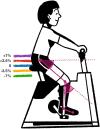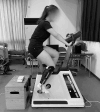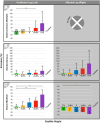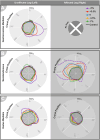Biomechanical effects of saddle height changes in leisure cycling with unilateral transtibial prostheses: A simulated study
- PMID: 39774461
- PMCID: PMC11706476
- DOI: 10.1371/journal.pone.0317121
Biomechanical effects of saddle height changes in leisure cycling with unilateral transtibial prostheses: A simulated study
Erratum in
-
Correction: Biomechanical effects of saddle height changes in leisure cycling with unilateral transtibial prostheses: A simulated study.PLoS One. 2025 Apr 1;20(4):e0321575. doi: 10.1371/journal.pone.0321575. eCollection 2025. PLoS One. 2025. PMID: 40168271 Free PMC article.
Abstract
Cycling is a beneficial physical activity for rehabilitating individuals with lower-limb amputations and serves as a feasible leisure sport. However, the optimal bicycle configuration for cycling with a unilateral transtibial prosthesis at leisure levels has not been investigated. For saddle height at professional cycling levels, existing literature suggests utilizing the same configuration as that used by intact cyclists, where the knee reaches 25-35° at maximum extension. However, leisure cyclists tend to select lower saddle heights, and cycling with a unilateral transtibial prosthesis infers altered biomechanics during cycling practice. This study aimed to investigate the effects of cycling at different saddle heights with a simulated unilateral prosthesis. Ten able-bodied participants wore orthoses to simulate prosthetic conditions. The experimental task was performed on an ergometer at 40 W resistance, 60 rpm to simulate leisure cycling. Standard saddle height was defined as maximum knee extension of 45°. This height was used as the control condition and its trials were performed without orthoses. The variable heights were set as height percentage variations (-7%, -3.5%, 0, +3.5%, and +7%). Muscle activity, joint movement, force application to the pedals, perceived exertion, and comfort were evaluated. The -3.5% and -7% saddle heights resulted in joint movement and muscle activity levels closer to those in the control conditions, which also showed improved power symmetry between the affected and non-affected legs. In addition, the -3.5% height increased comfort level in participants. In conclusion, selecting lower saddle heights may be beneficial for unilateral transtibial amputees during leisure cycling. The optimal saddle height for this population may maintain maximum knee extension within the 37-45° range, dynamically measured on the affected side.
Copyright: © 2025 Seratiuk Flores et al. This is an open access article distributed under the terms of the Creative Commons Attribution License, which permits unrestricted use, distribution, and reproduction in any medium, provided the original author and source are credited.
Conflict of interest statement
The authors have declared that no competing interests exist.
Figures









Similar articles
-
Cycling with Low Saddle Height is Related to Increased Knee Adduction Moments in Healthy Recreational Cyclists.Eur J Sport Sci. 2020 May;20(4):461-467. doi: 10.1080/17461391.2019.1635651. Epub 2019 Jul 16. Eur J Sport Sci. 2020. PMID: 31269871
-
The biomechanics of cycling with a transtibial amputation: Recommendations for prosthetic design and direction for future research.Prosthet Orthot Int. 2009 Sep;33(3):256-71. doi: 10.1080/03093640903067234. Prosthet Orthot Int. 2009. PMID: 19658015
-
Effects of bicycle saddle height on knee injury risk and cycling performance.Sports Med. 2011 Jun 1;41(6):463-76. doi: 10.2165/11588740-000000000-00000. Sports Med. 2011. PMID: 21615188 Review.
-
Effectiveness of force production in persons with unilateral transtibial amputation during cycling.Prosthet Orthot Int. 2011 Dec;35(4):373-8. doi: 10.1177/0309364611423129. Epub 2011 Oct 13. Prosthet Orthot Int. 2011. PMID: 21998095 Clinical Trial.
-
Biomechanical parameters of gait among transtibial amputees: a review.Sao Paulo Med J. 2009 Sep;127(5):302-9. doi: 10.1590/s1516-31802009000500010. Sao Paulo Med J. 2009. PMID: 20169280 Free PMC article. Review.
Cited by
-
Correction: Biomechanical effects of saddle height changes in leisure cycling with unilateral transtibial prostheses: A simulated study.PLoS One. 2025 Apr 1;20(4):e0321575. doi: 10.1371/journal.pone.0321575. eCollection 2025. PLoS One. 2025. PMID: 40168271 Free PMC article.
References
MeSH terms
LinkOut - more resources
Full Text Sources
Medical

